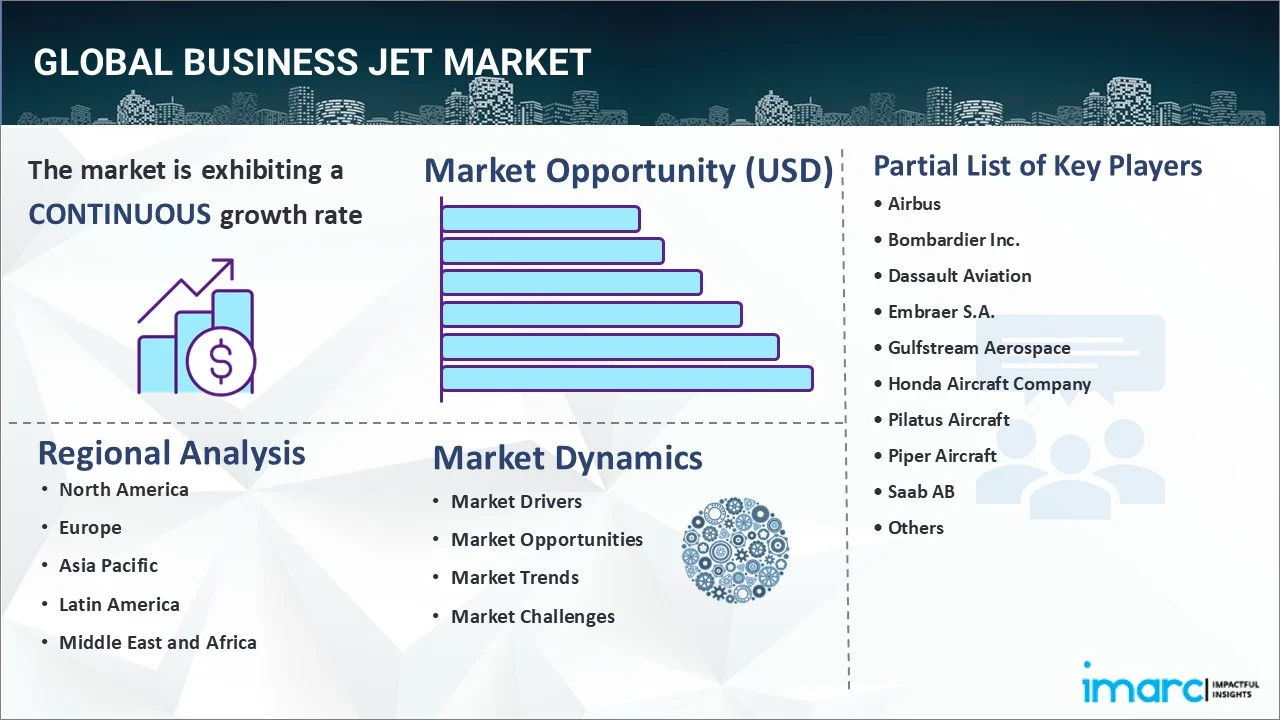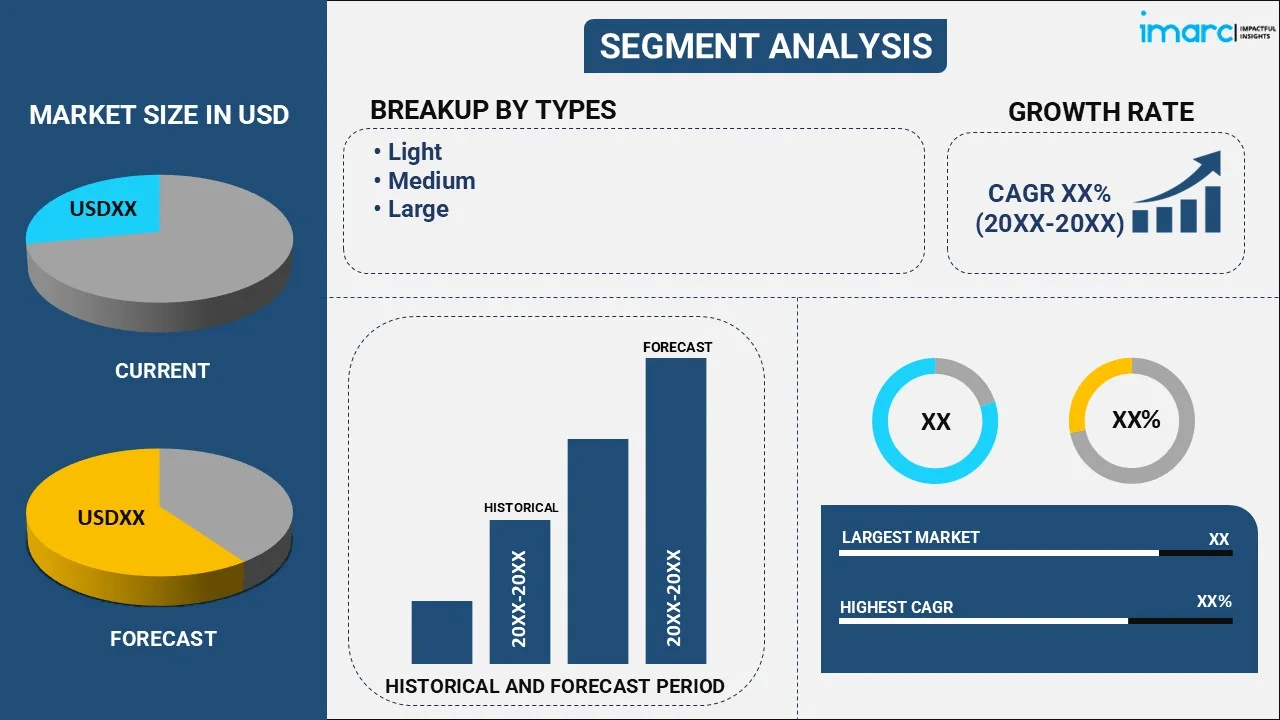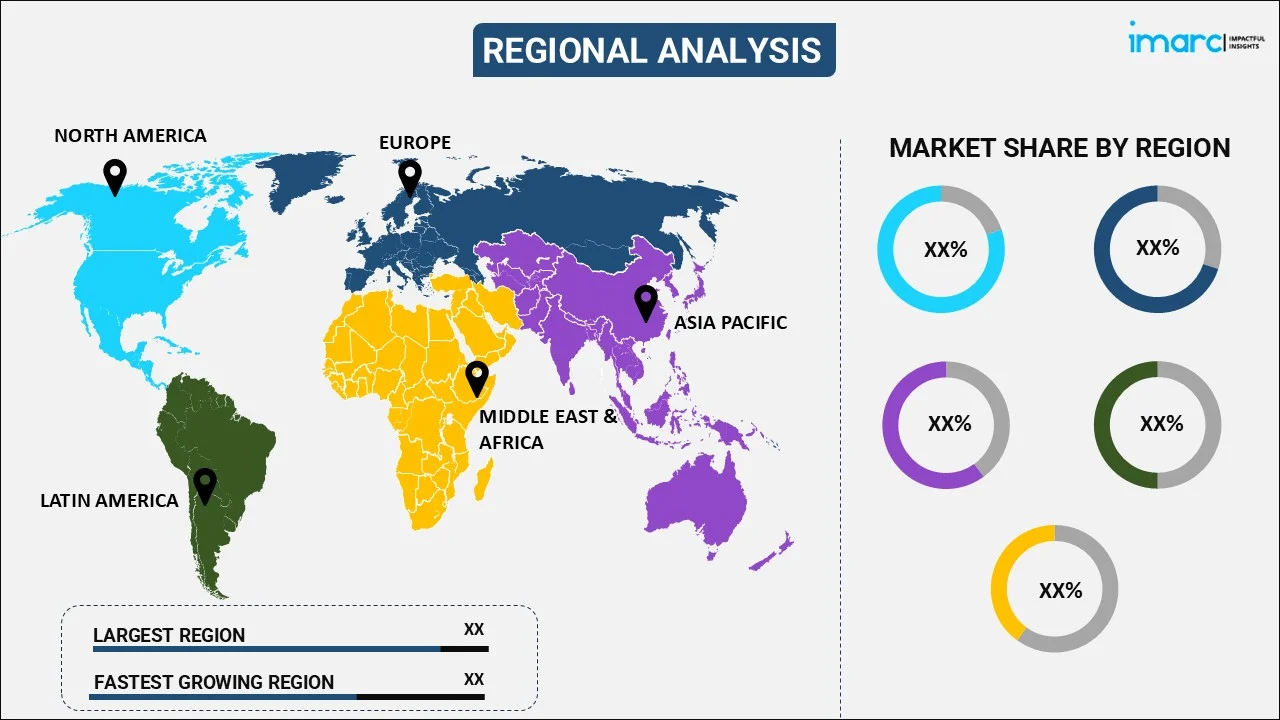
Business Jet Market Report by Type (Light, Medium, Large), Business Model (On-Demand Service, Ownership), Range (< 3,000 NM, 3,000 - 5,000 NM, > 5000 NM), Point of Sale (OEM, Aftermarket), and Region 2025-2033
Business Jet Market Size:
The global business jet market size reached USD 19.9 Billion in 2024. Looking forward, IMARC Group expects the market to reach USD 27.4 Billion by 2033, exhibiting a growth rate (CAGR) of 3.6% during 2025-2033. The increasing inclination towards business jets among corporate people, rising traction of fractional ownership and jet-sharing models, and the growing requirement for specialized medical transportation for urgent care are some of the major factors propelling the market.
|
Report Attribute
|
Key Statistics
|
|---|---|
|
Base Year
|
2024
|
|
Forecast Years
|
2025-2033
|
|
Historical Years
|
2019-2024
|
|
Market Size in 2024
|
USD 19.9 Billion |
|
Market Forecast in 2033
|
USD 27.4 Billion |
| Market Growth Rate (2025-2033) | 3.6% |
Business Jet Market Analysis:
- Major Market Drivers: The business jet market demand is on the rise, driven largely by the desire for faster and more streamlined transportation choices among corporate executives and affluent individuals.
- Key Market Trends: The market is changing by emphasizing the use of cutting-edge technology to enhance efficiency while reducing the impact on the environment. There is a business jet market trend towards creating airplanes with bigger cabins to increase comfort and making aircrafts capable of traveling long distances without stopping.
- Geographical Trends: North America remains at the forefront of the business jet industry, due to its significant wealth and a business culture that values time management.
- Competitive Landscape: The business jet market's competitive environment is characterized by intense competition among a small number of key players who are innovating in technology and customer service. Creating alliances and connections is a popular tactic to encourage technological advancement and broaden the range of services provided.
- Challenges and Opportunities: The industry encounters challenges such as stringent regulations and environmental issues that may impede expansion. Conversely, numerous advancements in eco-friendly aviation technologies and sustainable techniques have the potential to establish fresh industry norms and transform consumer expectations and regulatory structures.

Business Jet Market Trends:
Increasingly changing business cultures and work dynamics
Business jets facilitate fast in-person meetings and foster a culture of openness across various levels of a company. Therefore, this is significantly supporting the business jet market growth. According to National Business Aviation Association, business aviation plays a role in generating $150 billion for the U.S. economy and has a workforce of over 1.2 million individuals. General aviation in every state, which includes the sale of both new and used airplanes, as well as maintenance and operational support, brings about significant economic advantages. These business jet market statistics further support the rapidly growing demand across the globe. Executives can effectively manage their time and find a balance between work, travel, and personal commitments by traveling on a customized schedule. In addition, the demand for business jets is escalating due to their alignment with modern work cultures which is also increasing business jet market revenue.
Rise in regulatory support and infrastructure development
Governments and aviation authorities globally are acknowledging the financial advantages of business aviation. Efforts to simplify regulations, enhance airport infrastructure, and establish supportive policies are aiding in the market's expansion. Regulations for private jet operations in Federal Aviation Regulations (FAR) Part 91 are provided by the FAA. As per these instructions, the aircraft should be utilized solely for non-commercial reasons. These guidelines require the aircraft and the operator to follow particular rules for airport operations, weather and navigation services, and crew training. Thus, this also impacts the business jet market price. Apart from this, enhanced airport accessibility decreased red tape, and efforts to facilitate aviation funding are also prompting more companies to explore and utilize private jets.
Growing emphasis on safety and security
Safety and security are receiving more focus during travel. Business jets provide a regulated setting with increased safety measures, security protocols, and carefully selected crew members. This guarantees privacy and security for business and personal affairs, causing more companies and executives to choose business jet travel instead of regular commercial flights. For instance, International Standard for Business Aircraft Operations (IS-BAO) provides progressive programs to respond to the industry needs. Flight Plan Stage 1 provides a quick and easy route to Stage 1 registration for small operators with only one aircraft and one base. This comprehensive package for beginners includes expert support for implementation, a one-day audit (excluding aircraft inspection), and 6-month proficiency validations throughout the course, all for one flat fee. The Stage 3 program of the Progressive was created for experienced operators to make use of their sophisticated safety systems. Instead of the traditional Stage 3, this new program offers a personalized one-day audit and special entry to a fresh database on business aviation safety. Furthermore, these jets allow businesses to transport tools and materials safely when they are unable to be transported on commercial airlines, creating a positive business jet market outlook.
Business Jet Market Segmentation:
IMARC Group provides an analysis of the key trends in each segment of the global business jet market report, along with forecasts at the global, regional and country levels from 2025-2033. Our report has categorized the market based on type, business model, range and point of sale.
Breakup by Type:

- Light
- Medium
- Large
Large dominates the market
The report has provided a detailed breakup and analysis of the market based on the type. This includes light, medium, and large. According to the report, large represented the largest segment.
The large business jets are the most roomy and competent classification. They have the capacity to transport a large amount of passengers, typically ranging from 10 to 16. Additionally, their extended ranges, ranging from 3,000 to 6,000 nautical miles, allow for intercontinental travel without the need for refueling. They have the ability to fly at velocities of 530 knots or higher. In line with this, they also provide opulent and cozy interiors, usually with distinct areas for working, resting, and unwinding for the users. Therefore, this is positively influencing the business jet market demand.
Breakup by Business Model:
- On-Demand Service
- Air Taxis
- Branded Charters
- Jet-Card Programs
- Ownership
- Fractional Ownership
- Full Ownership
On-demand service holds the largest share in the market
A detailed breakup and analysis of the market based on the business model has also been provided in the report. This includes on-demand service (air taxis, branded charters, and jet-card programs) and ownership (fractional ownership and full ownership). According to the report, on-demand service accounted for the largest business jet market share.
In the on-demand service model, individuals or businesses have the option to rent a business jet for a specific trip or period of time, without actually purchasing the aircraft. This choice offers freedom for individuals to use a private jet as necessary without the obligations of owning one. Renting a private jet provides advantages like customized travel schedules, the option to select from different planes depending on the number of passengers and distance needs, and quick transportation to locations not easily reachable by regular airlines. Charter companies oversee and manage the aircraft, offering a convenient option for individuals seeking private travel without the burden of ownership expenses and long-term commitments.
Breakup by Range:
- < 3,000 NM
- 3,000 - 5,000 NM
- > 5000 NM
3,000 - 5,000 NM dominates the market
The report has provided a detailed breakup and analysis of the market based on the range. This includes < 3,000 NM, 3,000 - 5,000 NM, and > 5000 NM. According to the report, 3,000 - 5,000 NM represented the largest segment.
According to the business jet market overview, jets in this range can fly longer distances and cover 3,000 to 5,000 nautical miles without needing to refuel. These planes are appropriate for long-distance travel between continents or within larger countries. In addition to this, they offer increased range without sacrificing compactness, making them adaptable choices for a range of travel requirements. This category includes medium-sized and certain large business jets. For instance, data from Conklin & de Decker shows that the Gulfstream G650ER is the top performer in terms of nonstop range, whether fully loaded or with just four passengers, the typical number on a private jet trip. With only four passengers and a 7,685 nautical mile range, it could potentially fly directly between Bangkok and Chicago, but flights must account for fuel reserves in case a diversion is necessary. Thereby, this is favoring the business jet market share.
Breakup by Point of Sale:
- OEM
- Aftermarket
OEM holds the largest share in the market
A detailed breakup and analysis of the market based on the point of sale has also been provided in the report. This includes OEM and aftermarket. According to the report, OEM accounted for the largest market share.
The original equipment manufacturer (OEM) point of sale is when a business jet is bought directly from the manufacturer. Selecting the aircraft model, customizing features, and configuring the interior to meet specific preferences are usually involved in this purchase. Along with this, the point of sale from the OEM provides the benefit of purchasing a new aircraft with the most up-to-date technology, design, and features. It also covers manufacturer guarantees and assistance. According to business jet market statistics, Gulfstream had the largest market share of 37% among the eight business jet manufacturers in China in 2021. Bombardier held a market share of 28% in business jet market 2021.
Breakup by Region:

- North America
- United States
- Canada
- Asia Pacific
- China
- Japan
- India
- South Korea
- Australia
- Indonesia
- Others
- Europe
- Germany
- France
- United Kingdom
- Italy
- Spain
- Russia
- Others
- Latin America
- Brazil
- Mexico
- Others
- Middle East and Africa
North America exhibits a clear dominance, accounting for the largest business jet market share
The report has also provided a comprehensive analysis of all the major regional markets, which include North America (the United States and Canada); Asia Pacific (China, Japan, India, South Korea, Australia, Indonesia, and others); Europe (Germany, France, the United Kingdom, Italy, Spain, Russia, and others); Latin America (Brazil, Mexico, and others); and the Middle East and Africa. According to the report, North America is the largest region in business jet market.
The easy availability of various airports that ease in business travel represents one of the primary factors driving the business jet market demand in the North America region. In confluence with this, the rising penetration of business aviation is bolstering the market growth in the region. Besides this, the advent of hybrid-electric aircraft propulsion to increase the performance of business jet is also creating business jet market opportunities in the region. Moreover, the continuous technological advancements and changing consumer preferences are also acting as business jet market trends.
Competitive Landscape:
The market research report has also provided a comprehensive analysis of the competitive landscape in the market. Detailed profiles of all major companies have also been provided. Some of the major market players in the keyword industry include:
- Airbus
- Bombardier Inc.
- Dassault Aviation
- Embraer S.A.
- Gulfstream Aerospace
- Honda Aircraft Company
- Pilatus Aircraft
- Piper Aircraft
- Saab AB
- Textron Inc.
- The Boeing Company
(Please note that this is only a partial list of the key players, and the complete list is provided in the report.)
The key players are introducing business jets with advanced avionics systems such as synthetic vision displays, head-up displays (HUDs), and improved flight management systems. These aircraft also enhance pilots' understanding of their surroundings, particularly in challenging weather or low-visibility scenarios. Additionally, major participants are implementing cutting-edge in-flight entertainment systems for travelers to remain connected, conduct video meetings, and enjoy entertainment options while flying. Furthermore, the integration of lightweight composite materials in aircraft construction to improve performance through weight reduction and increased fuel efficiency is positively influencing the business jet market price. Along with this, the business jet market recent developments also include creating engines that are more fuel-efficient and environmentally friendly in order to decrease fuel consumption, emissions, and noise, as well as improve the range and capabilities of business jets.
Business Jet Market News :
- In 2022, Textron Inc. announced a purchase agreement with Exclusive Jets, LLC, operating as FlyExclusive, which is a leading provider of premium private jet charter experiences for up to 30 Cessna Citation CJ3+ jets.
- In October 2021, Airbus partnered with Alpha Star Aviation for the installation of new and unique In-flight Entertainment (IFE) technology in business jets.
- In 2023, Honda Aircraft Company announced that it will commercialize the HondaJet 2600 Concept, an all-new light jet that was first introduced at the 2021 NBAA Business Aviation Convention & Exhibition (NBAA-BACE).
Business Jet Market Report Scope:
| Report Features | Details |
|---|---|
| Base Year of the Analysis | 2024 |
| Historical Period | 2019-2024 |
| Forecast Period | 2025-2033 |
| Units | Billion USD |
| Scope of the Report | Exploration of Historical Trends and Market Outlook, Industry Catalysts and Challenges, Segment-Wise Historical and Future Market Assessment:
|
| Types Covered | Light, Medium, Large |
| Business Models Covered |
|
| Ranges Covered | < 3,000 NM, 3,000 - 5,000 NM, > 5000 NM |
| Point of Sales Covered | OEM, Aftermarket |
| Region Covered | Asia Pacific, Europe, North America, Latin America, Middle East and Africa |
| Countries Covered | United States, Canada, Germany, France, United Kingdom, Italy, Spain, Russia, China, Japan, India, South Korea, Australia, Indonesia, Brazil, Mexico |
| Companies Covered | Airbus, Bombardier Inc., Dassault Aviation, Embraer S.A., Gulfstream Aerospace, Honda Aircraft Company, Pilatus Aircraft, Piper Aircraft, Saab AB, Textron Inc., The Boeing Company, etc. |
| Customization Scope | 10% Free Customization |
| Post-Sale Analyst Support | 10-12 Weeks |
| Delivery Format | PDF and Excel through Email (We can also provide the editable version of the report in PPT/Word format on special request) |
Key Benefits for Stakeholders:
- IMARC’s industry report offers a comprehensive quantitative analysis of various market segments, historical and current market trends, market forecasts, and dynamics of the business jet market from 2019-2033.
- The research report provides the latest information on the market drivers, challenges, and opportunities in the global business jet market.
- The study maps the leading, as well as the fastest-growing, regional markets. It further enables stakeholders to identify the key country-level markets within each region.
- Porter's five forces analysis assists stakeholders in assessing the impact of new entrants, competitive rivalry, supplier power, buyer power, and the threat of substitution. It helps stakeholders to analyze the level of competition within the business jet industry and its attractiveness.
- The competitive landscape allows stakeholders to understand their competitive environment and provides insight into the current positions of key players in the market.
Key Questions Answered in This Report
The global business jet market was valued at USD 19.9 Billion in 2024.
We expect the global business jet market to exhibit a CAGR of 3.6% during 2025-2033.
The extensive adoption of business jets by private and government organizations for short-haul flights, leisure travel, business tours, VVIP transport, is primarily driving the global business jet market.
The sudden outbreak of the COVID-19 pandemic had led to the implementation of stringent lockdown regulations across several nations resulting in the temporary intra- and inter-national travel restrictions, thereby limiting the demand for business jets.
Based on the type, the global business jet market has been segmented into light, medium, and large. Among these, large business jets currently hold the majority of the total market share.
Based on the business model, the global business jet market can be divided into on-demand service and ownership. Currently, on-demand service exhibits a clear dominance in the market.
Based on the range, the global business jet market has been categorized into < 3,000 NM, 3,000 - 5,000 NM, and > 5000 NM. Among these, 3,000 - 5,000 NM currently accounts for the majority of the global market share.
Based on the point of sale, the global business jet market can be segregated into OEM and aftermarket. Currently, OEM holds the largest market share.
On a regional level, the market has been classified into North America, Asia Pacific, Europe, Latin America, and Middle East and Africa, where North America currently dominates the global market.
Some of the major players in the global business jet market include Airbus, Bombardier Inc., Dassault Aviation, Embraer S.A., Gulfstream Aerospace, Honda Aircraft Company, Pilatus Aircraft, Piper Aircraft, Saab AB, Textron Inc., The Boeing Company, etc.
Need more help?
- Speak to our experienced analysts for insights on the current market scenarios.
- Include additional segments and countries to customize the report as per your requirement.
- Gain an unparalleled competitive advantage in your domain by understanding how to utilize the report and positively impacting your operations and revenue.
- For further assistance, please connect with our analysts.
 Request Customization
Request Customization
 Speak to an Analyst
Speak to an Analyst
 Request Brochure
Request Brochure
 Inquire Before Buying
Inquire Before Buying




.webp)




.webp)












